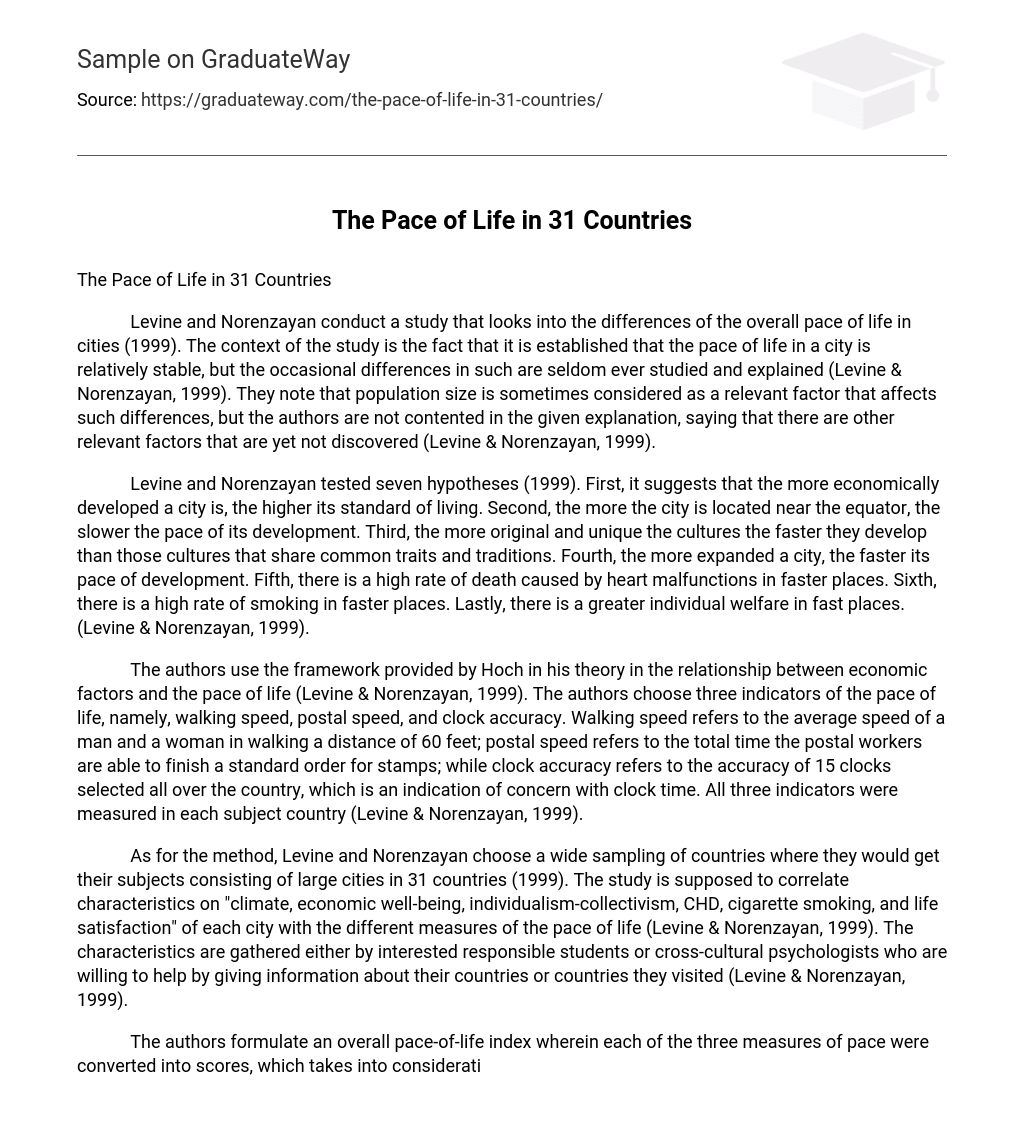Levine and Norenzayan conduct a study that looks into the differences of the overall pace of life in cities (1999). The context of the study is the fact that it is established that the pace of life in a city is relatively stable, but the occasional differences in such are seldom ever studied and explained (Levine & Norenzayan, 1999). They note that population size is sometimes considered as a relevant factor that affects such differences, but the authors are not contented in the given explanation, saying that there are other relevant factors that are yet not discovered (Levine & Norenzayan, 1999).
Levine and Norenzayan tested seven hypotheses (1999). First, it suggests that the more economically developed a city is, the higher its standard of living. Second, the more the city is located near the equator, the slower the pace of its development. Third, the more original and unique the cultures the faster they develop than those cultures that share common traits and traditions. Fourth, the more expanded a city, the faster its pace of development. Fifth, there is a high rate of death caused by heart malfunctions in faster places. Sixth, there is a high rate of smoking in faster places. Lastly, there is a greater individual welfare in fast places. (Levine & Norenzayan, 1999).
The authors use the framework provided by Hoch in his theory in the relationship between economic factors and the pace of life (Levine & Norenzayan, 1999). The authors choose three indicators of the pace of life, namely, walking speed, postal speed, and clock accuracy. Walking speed refers to the average speed of a man and a woman in walking a distance of 60 feet; postal speed refers to the total time the postal workers are able to finish a standard order for stamps; while clock accuracy refers to the accuracy of 15 clocks selected all over the country, which is an indication of concern with clock time. All three indicators were measured in each subject country (Levine & Norenzayan, 1999).
As for the method, Levine and Norenzayan choose a wide sampling of countries where they would get their subjects consisting of large cities in 31 countries (1999). The study is supposed to correlate characteristics on “climate, economic well-being, individualism-collectivism, CHD, cigarette smoking, and life satisfaction” of each city with the different measures of the pace of life (Levine & Norenzayan, 1999). The characteristics are gathered either by interested responsible students or cross-cultural psychologists who are willing to help by giving information about their countries or countries they visited (Levine & Norenzayan, 1999).
The authors formulate an overall pace-of-life index wherein each of the three measures of pace were converted into scores, which takes into consideration the correlation of the several components to each other and the pace of life (Levine & Norenzayan, 1999).
The authors discover that Japan and countries in Western Europe have the fastest pace of life (Levine & Norenzayan, 1999). Eight of the nine countries with the fastest pace of life came from Western Europe, while United States and Canada surprisingly placed only in the middle ranks.
This study provides significant literature to support the theory that previously untested predictors of pace of life, namely, climate, economy, and individualistic cultures, affect the pace of life. However, the study does not show that higher population causes a faster pace of life, because of the limited sampling of the subjects (Levine & Norenzayan, 1999).
To sum up, the study is able to show that the pace of life is influenced by many different community characteristics unique to a certain city or culture that gives it a distinct personality (Levine & Norenzayan, 1999).
The article succeeds in proving its hypotheses. However, the big number of hypotheses tested sacrificed the findings, as shown by the model’s failure to establish the relation of population size and the pace of life. It would have been better to focus on singular factors in order to establish a stronger correlation between the factor and the outcome.
Reference:
Levine, R. V. & Norenzayan, A. (1999). “The Pace of Life in 31 Countries.” Journal of Cross- Cultural Psychology 30(2), 178-205.





